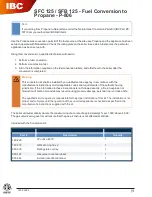
118
SYSTEM MANAGEMENT
5.9.1
Setting the main parameters
Some parameters are essential in order for the system to operate
in cascade and setting these parameters is a determining factor
for correct system operation.
5.9.2
Par.73 – Managing, Stand-alone,
Dependent mode.
Parameter 73 defines how the thermal unit is addressed and
serves to ensure that the signal from the secondary circuit sen-
sor is recognised.
Three values can be set:
−
1
to be set on the Managing module so that secondary
sensor operation is activated.
N.B.
The secondary sensor SC must be connected to the 2nd
burner (1st Depending module);
−
0
to be set on the Managing module so that secondary
sensor operation is deactivated;
−
2 ÷ 7
do not use. Address all the thermal units using the
dip-switches as shown in paragraph "Setting the dip-
Boiler Cascade
Settings
(73) Stand
Alone Boiler
Boiler Settings
Settings
Home/Menu
screen
5.9.3
Par.147 – No. thermal modules
Parameter 147 defines the number of thermal modules in the
system (it is important to set the numer of connected modules
for the system to work properly). This parameter must only be
set on the "Managing" module.
Cascade
Module Config.
(147) Number
of Units
Boiler Settings
Settings
Home/Menu
screen
5.9.4
Par.7 – heating setpoint hysteresis
The parameter 7 adjust shutdown of the individual modules
when the setpoint is exceeded. With cascade operation, this
value must be increased (up to a maximum of 20°C) to prevent
operation of the unit from being disabled (since the default val-
ue is 3°C) if the system decides to increase the setpoint based
on the value detected by the primary or secondary circuit sensor
(see explanation in paragraphs "General operation”, “Operation
with the primary sensor” and “Operation with the secondary
This parameter is to be modified (in the same way) on all mod-
ules of the cascade (Managing module and all the relative De-
pending modules).
Recommended value = 7
Parameters
(7)
Heat Hyst. Up
Home/Menu
screen
Boiler Settings
Settings
5.9.5
General operation
With cascade operation the managing unit regulator sets a set-
point to send to the depending units.
On the basis of the setpoint received from the Managing mod-
ule, each module modulates based on its own PID (Par 16, Par 17
and Par 18) as a function of the difference between the setpoint
(sent by the Managing module) and the value read by the deliv-
ery sensor on the module itself.
9
The PID is a Proportional-Integral-Derivative control system
(abbreviated to PID) with retro-action. By reading an input
value which determines the current value, it is able to re-
act in the event of a positive or negative error (difference
between the current value and the target value), tending
towards 0. Reaction to the error can be regulated through
the terms "proportional, integral, derivative".
5.10
Operation with primary circuit sensor
The system sensor (SS) present on the primary circuit allows the
setpoint sent to the individual units to be modulated based on
the difference between the setpoint set and the value read on
the delivery manifold of the primary system.
The following parameters regulate this modulation:
79
defines the maximum setpoint decrease
80
defines the maximum setpoint increase
81
defines the time (from the start of the request) from
which the setpoint modulation is started
86
proportional parameter for setpoint modulation
87
integrative parameter for setpoint modulation
5.11
Operation with secondary circuit sensor
When the secondary circuit sensor (SC) is present, the setpoint
sent to the units is modulated based on the difference between
the setpoint set and the value read on the delivery manifold of
the secondary system.
In the same way that modulation is based on the system sensor,
the following parameters intervene:
169
defines the maximum setpoint decrease
170
defines the maximum setpoint increase
171
defines the time (from the start of the request) from
which the setpoint modulation is started
176
defines the proportional term for setpoint modulation
177
defines the integrative term for setpoint modulation
















































